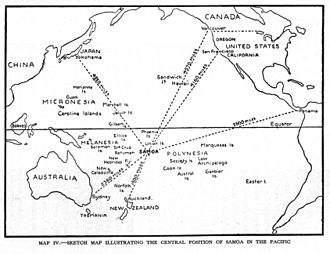

Archaeology of Samoa began with the first systematic survey of archaeological remains on Savai'i island by Jack Golson in 1957.[1] Since then, surveys and studies in the rest of Samoa have uncovered major findings of settlements, stone and earth mounds including star mounds, Lapita pottery remains and pre-historic artifacts.[2]
An important part of archaeology in Samoa and Oceania involves finding the answer to the origins of Polynesians,[3] ongoing research which is being undertaken in conjunction with other fields including linguistics and genetics.
The oldest date so far from pre-historic remains in Samoa has been calculated by New Zealand scientists to a likely true age of circa 3,000 BP (Before Present) from a Lapita site at Mulifanua during the 1970s.[4]
- ^ [1] Settlement Patterns in Samoa before 1840 by Janet M Davidson, The Journal of the Polynesian Society, Vol. 78 1969, No. 1, p.44-82. Retrieved 1 November 2009
- ^ [2] Samoan archaeology: a review of research history by Helene Martinsson-Wallin, Archaeology in Oceania, October 01, 2007. Retrieved 1 November 2009
- ^ [3] Samoan archaeology: a review of research history by Helene Martinsson-Wallin, Archaeology in Oceania, October 01, 2007. Retrieved 1 November 2009
- ^ [4] Archived 2011-05-10 at the Wayback Machine New Information for the Ferry Berth Site, Mulifanua, Western Samoa by Roger C. Green & Helen M. Leach, Journal of the Polynesian Society, Vol. 98, No. 3, 1989. Retrieved 29 December 2009
